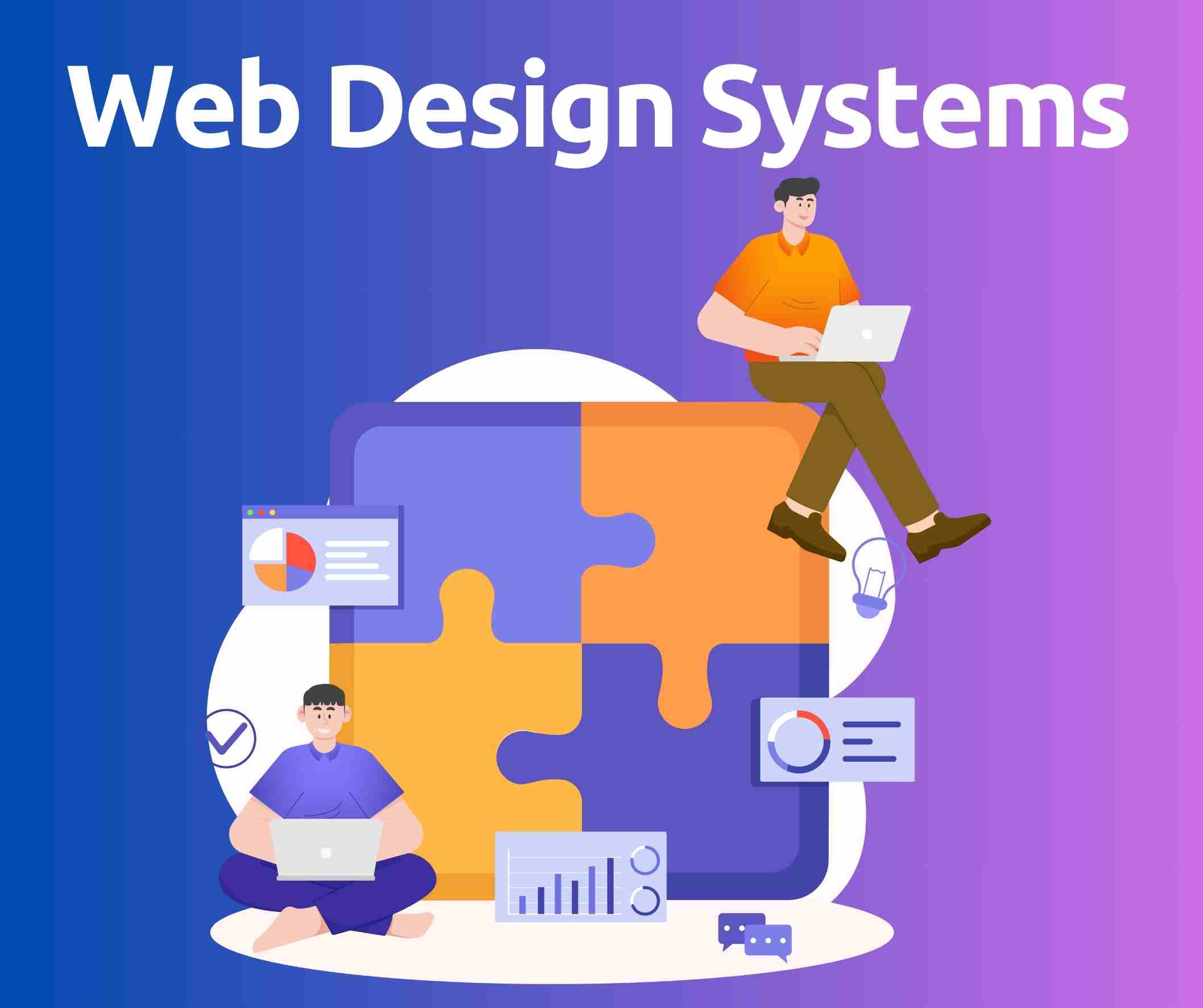Web Design Systems: The Comprehensive Guide

Web Design Systems – In the ever-evolving landscape of web design, the need for creating seamless and consistent user experiences has never been more crucial. Web design systems have emerged as a powerful solution to address this challenge, providing a structured approach to design that ensures harmony across digital platforms. This comprehensive guide delves into the intricacies of web design systems, exploring their definition, components, benefits, and the process of implementing them.
The Comprehensive Guide to Web Design Systems: Crafting Cohesive and Consistent User Experiences
A. Understanding Web Design Systems
What is a Web Design System?
A web design system is a set of interconnected components and guidelines that work together to create a unified digital experience. It acts as a centralized resource for design elements, patterns, and principles, facilitating the development of cohesive and user-friendly interfaces. Web design systems encompass a range of assets, from color palettes and typography to UI components and interaction patterns.
B. Components of a Web Design System
Design Principles:
- Establishing core design principles serves as the foundation of a web design system. These principles guide the decision-making process, ensuring consistency and coherence in design choices.
Typography:
- Consistent typography is crucial for readability and brand identity. Web design systems define font styles, sizes, and spacing to maintain a uniform text hierarchy across various digital assets.
Color Palette:
- A well-defined color palette contributes to brand recognition and sets the tone for the user experience. Web design systems outline primary and secondary colors, as well as their appropriate usage.
UI Components:
- Building blocks of the user interface, such as buttons, forms, and navigation elements, are standardized through UI components. These components maintain a consistent visual language and enhance the usability of the interface.
Iconography:
- Icons play a crucial role in visual communication. A web design system includes a set of icons with consistent styling and meanings, ensuring a coherent language across the entire platform.
Layout Guidelines:
- Consistent layout guidelines establish the spatial relationships between elements, providing a framework for designing pages and screens. This includes grid systems, spacing rules, and responsive design considerations.
Interaction Patterns:
- Defining how users interact with the interface is essential for a seamless experience. Web design systems include guidelines for common interaction patterns, such as animations, transitions, and feedback mechanisms.
Accessibility Standards:
- Ensuring that digital products are accessible to users with diverse needs is a fundamental aspect of web design systems. Guidelines for creating accessible designs, including proper contrast ratios and keyboard navigation, are incorporated into the system.
Documentation:
- Comprehensive documentation is a key component of a web design system. It provides designers, developers, and other stakeholders with the necessary information to understand and implement the system effectively.
Design Tokens:
- Design tokens are variables that store visual design attributes such as colors, typography, and spacing. They provide a consistent and scalable way to manage design properties across different platforms.
C. The Benefits of Web Design Systems
Implementing a web design system offers a myriad of advantages, impacting both the efficiency of the design and development processes and the overall quality of the user experience.
1. Consistency Across Platforms:
- One of the primary benefits of a web design system is the ability to maintain visual and functional consistency across various digital platforms. Whether users interact with a website, mobile app, or other digital interfaces, a cohesive experience reinforces brand identity and user trust.
2. Time and Cost Efficiency:
- By providing a centralized resource for design assets and guidelines, web design systems streamline the design and development process. Designers and developers can reuse components and patterns, reducing the time and cost associated with creating new elements from scratch.
3. Scalability:
- Web design systems are inherently scalable. As digital products evolve and new features are introduced, the system adapts by expanding its library of components and guidelines. This scalability ensures that the design remains cohesive even as the platform grows.
4. Faster Prototyping and Development:
- With a well-established set of UI components and design patterns, the prototyping and development phases become more efficient. Designers can quickly create prototypes, and developers can implement features without the need for extensive design iterations.
5. Enhanced Collaboration:
- A web design system serves as a common language for designers, developers, and other stakeholders involved in the digital product development process. This common ground fosters better collaboration, as everyone works from the same set of guidelines and assets.
6. Improved User Experience:
- Consistency in design not only benefits the development team but also significantly enhances the user experience. Users become familiar with the interface, leading to improved usability, reduced cognitive load, and an overall positive perception of the digital product.
7. Adaptability to Changing Trends:
- Web design systems are designed to evolve with changing design trends and technological advancements. Updates to the system can be implemented strategically, ensuring that the digital product remains relevant and visually appealing over time.
8. Brand Cohesion:
- Maintaining a consistent visual language contributes to brand cohesion. Users should be able to recognize and associate a digital product with its brand, whether they are interacting with it on a website, mobile app, or any other platform.
9. Facilitates Design Iterations:
- Designers can iterate on existing components and patterns within the web design system, allowing for continuous improvement without deviating from the established design principles. This iterative process contributes to the refinement of the overall user experience.
10. Easier Onboarding for Team Members:
SQL
– New team members, whether designers or developers, can quickly familiarize themselves with the design and development standards by referring to the web design system documentation. This accelerates the onboarding process and ensures a consistent output from all team members.
D. Implementing a Web Design System
1. Define Design Principles:
- Begin by establishing the core design principles that will guide the entire web design system. These principles should align with the brand identity and user experience goals. Examples of design principles include simplicity, consistency, and accessibility.
2. Conduct a Design Audit:
- Before creating a web design system, conduct a comprehensive design audit of existing digital products. Identify common design elements, patterns, and inconsistencies that need to be addressed. This audit serves as a foundation for the components included in the web design system.
3. Create a Component Library:
- Develop a library of UI components based on the findings from the design audit. This includes buttons, forms, cards, navigation bars, and other elements that make up the user interface. Each component should have defined styles, states, and usage guidelines.
4. Establish Design Tokens:
- Design tokens are variables that store design attributes such as colors, typography, and spacing. By defining design tokens, you create a scalable and consistent way to manage design properties across different platforms and devices.
5. Design Documentation:
- Comprehensive documentation is critical for the successful implementation of a web design system. Document design principles, component guidelines, usage examples, and any other information that designers and developers may need. This documentation serves as a reference for the entire team.
6. Collaboration and Training:
- Ensure that all team members are familiar with the web design system and understand how to use its components. Conduct training sessions if necessary and encourage collaboration among designers and developers to ensure a smooth transition to the new design standards.
7. Iterative Development:
- Recognize that a web design system is not a static entity. It should evolve over time to accommodate changes in design trends, user feedback, and technological advancements. Implement an iterative development process to refine and expand the system as needed.
8. Testing and Feedback:
- Before fully implementing the web design system, conduct thorough testing to identify any issues or inconsistencies. Gather feedback from designers, developers, and users to make necessary adjustments. This testing phase is crucial for ensuring that the system performs as intended.
9. Integration with Development Workflow:
- Integrate the web design system seamlessly into the development workflow. This may involve incorporating the system into design tools, version control systems, and deployment processes. The goal is to make it easy for the development team to adopt and implement the design standards.
10. Maintain and Update:
SQL
– Regularly maintain and update the web design system to keep it aligned with the evolving needs of the digital product. This includes adding new components, updating design tokens, and refining documentation. A well-maintained system ensures continued consistency and relevance.
E. Case Studies: Successful Web Design System Implementations
To further illustrate the impact and success of web design systems, let’s explore two case studies from prominent organizations that have effectively implemented and benefited from these systems.
1. Salesforce Lightning Design System
Salesforce, a leading customer relationship management (CRM) platform, introduced the Salesforce Lightning Design System to ensure a consistent and modern user experience across its suite of products. The design system includes a comprehensive library of UI components, design guidelines, and code snippets that enable developers to build applications with a unified look and feel.
Key Features:
- Extensive Component Library: The design system provides a rich library of UI components, ranging from buttons and forms to complex data visualizations, ensuring that developers can create cohesive interfaces.
- Accessibility Focus: Salesforce places a strong emphasis on accessibility within its design system, ensuring that its products are usable by individuals with diverse needs.
- Collaboration with the Community: The Salesforce Lightning Design System is an open-source project, encouraging collaboration with the design and development community. This open approach has led to continuous improvements and contributions from a wide range of stakeholders.
Results:
- Consistent User Experience: The Salesforce Lightning Design System has played a pivotal role in unifying the user experience across Salesforce’s extensive product ecosystem, fostering familiarity and usability.
- Time and Cost Savings: Developers can leverage pre-built components and design patterns, saving time and reducing the cost of development. This efficiency is especially valuable in the agile and fast-paced development environment.
2. IBM Carbon Design System
IBM’s Carbon Design System serves as the foundation for creating digital experiences for IBM’s enterprise products. With a focus on scalability and flexibility, the Carbon Design System provides a robust set of guidelines and components for designers and developers.
Key Features:
- Modular Component System: The Carbon Design System is built on a modular architecture, allowing developers to assemble components in various combinations to create diverse interfaces while maintaining consistency.
- Data Visualization Components: Given IBM’s emphasis on data and analytics, the Carbon Design System includes a range of data visualization components, enabling the creation of powerful and insightful dashboards.
- Design Tokens for Consistency: Design tokens within the system ensure that design properties such as color, typography, and spacing remain consistent across different platforms and devices.
Results:
- Scalable Design: The modular and scalable nature of the Carbon Design System allows IBM to maintain a cohesive design language across a vast array of products and services.
- Empowered Development Teams: Developers have the flexibility to use pre-built components or customize them based on project requirements. This empowers development teams to create unique yet consistent interfaces.
F. Future Trends in Web Design Systems
As technology and design practices continue to evolve, several trends are emerging in the realm of web design systems. Staying abreast of these trends is essential for organizations seeking to maintain a cutting-edge and user-centric approach to digital design.
1. Design Systems for Augmented and Virtual Reality:
- As augmented reality (AR) and virtual reality (VR) technologies become more prevalent, the need for design systems tailored to these immersive experiences is on the rise. Designing consistent and intuitive interfaces in AR and VR environments presents unique challenges that specialized design systems can address.
2. Inclusive Design Systems:
- The emphasis on inclusivity in digital design is growing, and future web design systems are likely to incorporate even more robust accessibility features. Design systems that prioritize inclusive design ensure that digital products are accessible to users with a wide range of abilities and disabilities.
3. Integration with AI and Machine Learning:
- The integration of artificial intelligence (AI) and machine learning (ML) into digital products is becoming increasingly common. Future design systems may include guidelines for incorporating AI-powered features and ensuring a seamless user experience in applications that leverage intelligent technologies.
4. Micro-Interactions and Animation Systems:
- Micro-interactions and animations play a crucial role in enhancing user engagement and delight. Future web design systems may include dedicated guidelines and components for micro-interactions, providing designers with tools to create fluid and meaningful animations within the user interface.
5. Cross-Platform Design Systems:
- With users accessing digital products across a multitude of devices and platforms, the need for cross-platform design systems is evident. Future design systems may place a stronger emphasis on providing guidelines for creating cohesive experiences across web, mobile, desktop, and other emerging platforms.
6. Collaboration with AI Design Tools:
- The collaboration between designers and AI-powered design tools is likely to become more seamless. Design systems may integrate with AI tools to automate certain aspects of the design process, allowing designers to focus on more strategic and creative aspects of their work.
7. Dynamic and Adaptive Design Systems:
- Future design systems may evolve to become more dynamic and adaptive, responding to user behavior, preferences, and contextual factors. This adaptability can contribute to more personalized and context-aware user experiences.
Conclusion: Web Design Systems
In the dynamic landscape of web design, the adoption of web design systems has proven to be a game-changer for organizations aiming to deliver consistent and user-friendly digital experiences. From defining design principles to creating comprehensive documentation, the process of implementing a web design system requires careful planning and collaboration among design and development teams.
The benefits of web design systems extend beyond visual consistency, encompassing time and cost efficiency, scalability, and improved collaboration. Successful implementations by industry leaders such as Salesforce and IBM demonstrate the positive impact that well-executed design systems can have on the overall user experience and brand identity.
As organizations continue to embrace the power of web design systems, staying attuned to future trends is essential. The integration of AR and VR, a focus on inclusive design, and collaboration with AI are among the trends shaping the future of design systems. By evolving alongside these trends, organizations can ensure that their design systems remain not only relevant but also at the forefront of innovation in the digital design space.
Recommended Posts

Local SEO vs. Global SEO: A Comprehensive Guide
May 14, 2025



